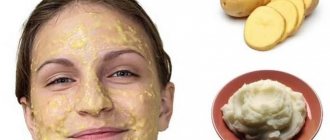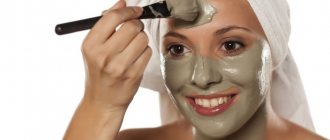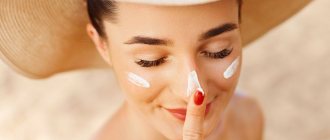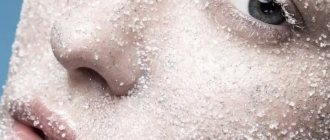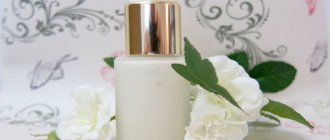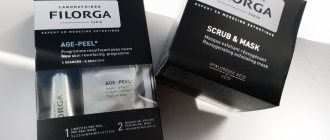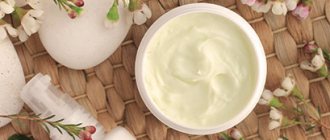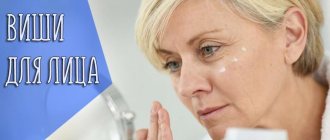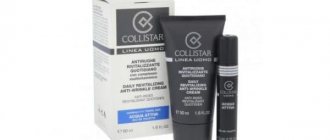A scrub is a good way to cleanse your face. It makes it possible not only to restore the healthy appearance of the skin, but also to remove scars, spots and other defects.
However, not every person who uses such a cleanser knows that after peeling the epidermis needs abundant hydration. Only proper care before and after the procedure will ensure a predominantly productive result.
How to prepare your face for scrub treatments?
The first thing you need to do is remove your decorative cosmetics. Applying any cleansing composition over foundation or highlighter is a real crime, for which you will have to pay for a long time. Don't want your pores to clog even more? Use milk or micellar water!
Then it is very important to wash your face again. Yes, it's necessary. The cosmetics are still at least somewhere, but they remain. In addition, now there are also traces on the skin of the products you used to remove foundation and powder. When everything is done, you can start scrubbing.
By the way, it would be nice if everything happens in a bathhouse, sauna or in a bathroom filled with steam. The more you steam your face, the more the pores will open.
Read also: Potassium sulfate (potassium sulfate)
@lorealparisusa.com
Scrub reduces acne
Facial scrubs also help reduce scars, scars and dark spots left on the skin after acne. Unfortunately, you won’t be able to completely get rid of the effects of acne, but they will become lighter because the scrub promotes the skin’s natural resurfacing process.
Massage your face with gentle movements to avoid damaging your skin
Clay facial scrub - traditional medicine recipes
Natural clay scrub at home - used on the face as an absorber of oil, dirt and toxins. Using a scrub with clay: stimulates blood circulation, acts as a medicinal and cosmetic product that tightens pores, cleanses and smoothes the skin surface.1. Revitalizing Recipe: Mix two tablespoons of clay powder, a tablespoon of thyme and a tablespoon of dried sage leaves. Add two drops of thyme essential oil and two drops of sage essential oil, then gradually dilute the resulting powder with hot water to form a thick paste. Apply the product to your face and rub over the skin with your fingertips.
—//—//—
Types of scrubs
All scrubs are divided into 2 types. The classification is based on the composition.
- Oil-based products. Abrasive particles: ground grape seeds, olives, coffee beans, salt, sugar. Natural and synthetic oils are used. Consistency in the form of a paste or lotion. Often used for additional skin nutrition during treatments in spa salons.
- Water-based products. Synthetic abrasive particles: cellulose, silicone. Contains essential oils. Consistency of gel, lotion, emulsion.
In addition, there is another classification of cosmetic products:
- Clay scrubs are intended for oily and combination skin. Quickly removes oily shine and tightens pores.
- Cream – suitable for hypersensitive, dry skin.
- Gel - universal, for all skin types.
The third division by type is regarding body parts:
- for face;
- legs;
- hands;
- of the whole body;
- lips;
- hair.
Each of these means is used according to certain rules. It is necessary to select based on the individual characteristics of the skin.
Peeling after a clay mask. Benefits of clay for the face
Cosmetic clay has a porous structure, due to which it absorbs sebum and impurities. Deeply and carefully cleanses, removes dead skin cells, makes the complexion look fresher, and eliminates inflammation.
Any type of clay has these properties, but there are differences. They are due to the fact that different microelements predominate in them. This is also the reason why clay can be multi-colored.
- White Due to the fact that it is based on a mineral called “kaolinite,” white clay is often called kaolin. One of its properties is skin whitening. Homemade white clay face masks help even out your complexion and make freckles less pronounced. Its ability to narrow pores and provide a lifting effect is also valued. At the same time, it is an excellent absorbent and a good antiseptic.
- Blue It is mined in Bulgaria and Crimea. The clay has a bluish tint due to the fact that it contains silver. Thanks to this, it has a pronounced antiseptic effect. Therefore, masks based on it are recommended for acne. Improves cellular metabolism, due to which it has a rejuvenating effect.
- Green Recommended for mature skin. Smoothes wrinkles, increases the firmness of the dermis and its elasticity. Thanks to zinc, it has pronounced antiseptic properties, mattifies the skin, and dries out inflammation.
- Yellow Famous for its ability to remove toxins. Improves blood circulation, saturates epithelial cells with oxygen. Tones the skin. Suitable for caring for aging skin.
- Red Contains microelements (iron, copper, manganese), which improve the condition of capillaries and saturate the epithelium with oxygen. Suitable for sensitive skin.
- Pink Combines the properties of white and red clay. Also suitable for the care of delicate skin.
- Black Contains quartz, calcium, iron. Stimulates blood circulation and metabolic processes. Helps get rid of toxins, fat deposits, accelerates regeneration. Helps restore a clear facial contour.
Using a body scrub
To make your skin smooth, even, and silky, it is recommended to use a scrub for the entire body 1-2 times a month.
- The procedure is carried out when the skin is well steamed - in the shower, bath, sauna, bathhouse.
- Distribute with light movements over the entire surface of the body. Avoid places where the skin is especially thin and sensitive.
- Lightly massage.
- Leave for 1-2 minutes to distribute the nutritional components. Every cosmetic product contains them.
- Wash off well with water at a comfortable temperature.
How to use foot scrub
The skin on the feet is rougher, and corns often appear. Scrubbing will bring it back to normal. It should be remembered that the procedure cannot be carried out with open calluses, painful cracks, or inflammation. The product can be chosen in the form of soap, gel, paste, cream. For massaging on rough areas of the skin, you can use a pumice stone. Typically, a foot scrub contains antibacterial, anti-inflammatory, and nutritional components. Removes unpleasant odor and normalizes the functioning of the sebaceous glands. You can prepare the product yourself.
- Mix 1 tbsp. spoon of oatmeal, 2 tbsp. spoons of cream, the same amount of ground nuts - walnuts, hazelnuts, almonds.
- 1 teaspoon of sugar is mixed with 1 tbsp. spoon cocoa, 2 tbsp. spoons of milk.
- Mash one tomato well with a fork, add 1 tbsp. spoon of sea salt.
Apply the composition for 5 minutes, massage well with a brush and pumice stone. Wash off with water and apply nourishing cream.
Rules for using lip scrub
The skin on the lips is extremely sensitive. If the product is not chosen correctly, it can be easily damaged. It is not recommended to carry out the procedure if there are cracks, jams, herpes, or other inflammations. Lip peeling is carried out in beauty salons. You can easily prepare the product at home.
- Olive or sunflower oil (1 teaspoon) is mixed with brown sugar (50 g). Apply the finished product using a soft toothbrush and massage for about 2 minutes. Wash off with warm water.
- Coffee grounds are mixed with kefir, cream, sour cream. Apply to lips, leave for 2 minutes, massage lightly, rinse.
- Sugar in the amount of 7 g is mixed with 5 ml of liquid honey. Add 1 drop of mint essential oil. Massage for several minutes.
Rules of application:
- Steam the skin of your lips. To do this, moisten a napkin with hot water and apply it to the surface of the lips. They do this several times.
- Direct application with light movements. Massaging is allowed with a soft toothbrush.
- Hold for 2 minutes.
- Rinse with warm water.
Remaining moisture is removed with a napkin. After peeling, the skin on the lips becomes elastic, soft and smooth. The sponges themselves increase somewhat in volume.
How do solarium scrubs differ from regular scrubs?
The main criteria for choosing a scrub to prepare for tanning sessions are:
- composition of a cosmetic product adapted for tanned skin;
- natural nutritional extracts;
- formula enriched with vitamins and minerals;
- moisturizing components that prevent overdrying;
- delicate effect on the skin.
Shower gels Hempz
The basis of this group of cosmetics from the American brand Hempz is the natural power of nature: hemp seed extract has been used for many years to effectively combat age-related changes, aloe vera promotes deep hydration of the skin, and marshmallow and comfrey extracts restore the skin, making it more elastic and silky. .
General recommendations for care and whether it is possible to do peeling immediately after cleansing your face
What procedures are allowed and recommended after cleansing the face depends on what method the cosmetologist used to tidy up the skin. There are a number of general recommendations regarding facial care after cleansing:
- It is highly not recommended to use the scrub for 7 days, as its small particles can cause mechanical damage, which can lead to inflammation or the appearance of a rash.
- Cosmetic facial cleansing makes the skin vulnerable to weather conditions; this is a temporary phenomenon, but for several days after the procedure it is highly recommended not to be in the sun often and to reduce the time spent outside during frost or strong winds.
- Bathhouse, sauna, solarium - you need to forget about them for a week. Skin weakened after cleansing is not able to properly perceive ultraviolet rays.
- It is also worth postponing water procedures, in particular visiting the pool, swimming in natural reservoirs.
- If facial cleansing was carried out in the summer, it is necessary to use special creams that prevent the negative effects of ultraviolet radiation, and sunscreen should be applied to the face until the end of the hot season. You can find out about the device for ultrasonic facial cleansing here.
Cosmetological facial cleansing provokes the appearance of redness, and in frequent cases, a rash. These side effects are temporary, but most women want to get radiant, smooth and beautiful skin as quickly as possible, and therefore begin to take measures to care for it on their own. Any procedures: masks, peeling, applying cream - all this must be agreed upon with a cosmetologist, since the wrong approach to facial care can cause great harm.
Video of peeling after facial cleansing:
Precautions after procedures
The peeling that can be used after cleansing the face depends on the type of cosmetic procedure. After laser treatment, when the negative effects on the skin are minimized, precautions are as follows:
- do not use a scrub;
- Do not expose your face to the sun's rays and wind for 2 days;
- avoid temperature changes.
Care after ultrasonic cleansing includes the application of various nourishing masks and gentle peeling without the use of harsh scrubs. There is no prohibition regarding being outdoors under ultraviolet rays. Measures to restore the skin after acid facial cleansing include nourishing masks, peeling using special cosmetic products, scrubs and other mechanical effects are strictly prohibited. You can find out which is better: mechanical or ultrasonic facial cleansing here.
Acid cleansing involves the aggressive action of special chemicals. During the month, it is strictly forbidden to visit the solarium or stay in the open rays of the sun for a long time.
Carrying out mechanical facial cleansing in a salon is a procedure in which the skin is subjected to severe trauma and irritation. Care after such a procedure must be clearly agreed with the doctor. Injured skin requires special care, since open pores can become an excellent breeding ground for infectious microflora. To avoid extremely unpleasant consequences, you must carefully follow and follow all the cosmetologist’s instructions for peeling.
Regardless of which method of facial cleansing was used, aggressive or as gentle as possible, it is strictly not recommended to use cosmetics for several days after the procedure.
How not to ruin your skin with a scrub
- Before using the scrub, check whether it will cause an allergic reaction. To do this, apply a little product to the crook of your elbow and leave for a few minutes. If there is no itching or redness, you can safely use this scrub.
- Choose a product with high-quality abrasive. For example, apricot kernels, after careless processing, may have sharp edges that can scratch the skin. As a result, inflammation may appear or, if the abrasive damages the pimple, acne may develop.
- Do not overdo it. Use the scrub gently without applying excessive pressure. Otherwise, there may be a thinning of the lipid layer, which protects the skin from the penetration of bacteria and viruses, aggressive components of cosmetics, dehydration and ultraviolet radiation.
- Do not use a scrub instead of shower gel. Before scrubbing, you should cleanse your skin of sweat and dirt. If this is not done, pathogenic microflora can penetrate the microdamages left by the scrub and cause irritation.
- Contact a cosmetologist or dermatologist if you have hypersensitive skin or rosacea. A specialist will monitor the process of using scrubs and, if necessary, replace the exfoliant.
When using scrubs based on Epsom salts, the risk of harming the skin is minimal. They are tested for effectiveness and safety. Salt gently exfoliates the skin and at the same time disinfects any micro-scratches. Organic components in combination with natural essential oils restore the lipid membrane and nourish the skin. Choose your scrub - help your skin always look fresh, well-groomed and radiant with health!
Stock up on Dead Sea scrubs and bath salts for 25% off* with promo code BLOG and use them in your own beauty recipes.
*Only for new clients.
Hand scrub
You can use the scrub once every 7 days. Apply a cosmetic product to the steamed skin, massage for 2 minutes, rinse, and moisturize with cream. It’s very easy to prepare a hand scrub; if you don’t have a store-bought one, you can make it yourself.
- Apply honey to the skin of your hands, sprinkle sugar on top. If the honey is candied, use only that.
- Sea salt is mixed with sour cream in equal proportions. Add 5 drops of your favorite essential oil.
- Grind apricot kernels and mix with cream.
What are scrubs made from?
Any scrub, purchased or made at home, consists of two basic elements - a base and exfoliating particles (abrasives). The base can be a cream or gel texture or various oils. Abrasive particles can be synthetic or natural.
Natural particles are usually harder and may develop sharp corners and uneven shapes when ground. However, these are natural substances that are safe for both the skin and the environment. They effectively cleanse and renew the epidermis, and in addition, they can be used in homemade scrubs.
The advantage of synthetic abrasive particles is that they are softer, rounder, smoother, and more gentle on the skin. But many brands are gradually abandoning them in favor of natural ones, so as not to harm the environment: after all, when washing off the scrub, such particles end up in wastewater.
Each component has its own important mission in scrubbing:
- The base,
rich in oils and active ingredients, helps soften the process and delicately cares for the skin. - Abrasives
perform the most important role - exfoliate dead skin particles. - Cosmetic clay
dries the skin and helps fight excess sebum production. - Antiseptics
kill harmful bacteria. - Acids and enzymes
enhance the effect of the scrub and help cleanse the skin deeper. - Menthol and essential oils
normalize the formation of sebum and have a tonic effect.
How scrubs work
The scrub has a mechanical effect, tearing off dead skin particles. A change in the relief for the better is noticeable after the first procedure. Since the skin is injured, the body produces a corresponding reaction - it produces collagen. It is this protein that is responsible for the strength, density and elasticity of the skin.
Scrubbing is often used as a complex therapy in the treatment of cellulite. Massage with abrasive particles activates blood microcirculation and lymph flow, as a result, excess fluid is removed and the skin is smoothed.
Peeling with a scrub cleanses the pores efficiently, so that the active substances penetrate the epidermis more freely. Therefore, after the procedure, you should apply a caring or anti-cellulite cream, nourishing lotion or milk.
Benefits and recipe for body scrub with Epsom salt and coffee
What is a facial scrub for?
The process of exfoliating dead skin cells is called “exfoliation.” In fact, this is a completely harmless and useful procedure, available at home. Dead cells clog the surface of the skin, interfere with the penetration of moisture, cleansing and regeneration, because of them, pores become clogged, blackheads and sebaceous plugs appear, and the complexion becomes dull. If the skin does not breathe, does not receive moisture and is not renewed, spots, fine wrinkles, redness and peeling appear on it. In addition, you can buy the most effective face cream, but it simply will not penetrate the stratum corneum of the epidermis and will not have the desired effect.
Regular exfoliation:
- cleanses the skin efficiently and deeply;
- prevents the appearance of blackheads and sebaceous plugs;
- stimulates skin regeneration, gives a rejuvenating effect;
- softens and smoothes facial skin, improves appearance;
- increases the effectiveness of subsequent care products: creams, serums and masks.
It is especially important to use a scrub after 25 years: at this time, the body’s natural regeneration processes slow down, so it needs help to maintain youth and health. Scrubbing should become a regular self-care ritual! We’ll talk further about how often you need to use a scrub and how to do it correctly.
Skin care rules after
When the scrub is washed off (with ordinary warm water!), you can proceed to the next stages of care. This time is considered the best for applying creams and masks. So, you can safely take off the shelves everything that nourishes, moisturizes, rejuvenates and increases elasticity.
Additionally, after scrubbing, you can remove excess facial hair. The process will go much faster and easier.
Also, after such peeling, you can safely use traditional cosmetology products. The effect of herbal decoctions and lotions will be noticeable much faster.
What you should not do is use products containing acids. This can cause significant damage to skin injured by small abrasive particles.
Which facial scrub is suitable for sensitive skin?
Which facial scrub to choose is a task that can be solved in two ways: by consulting with a cosmetologist or by selecting a product by trial and error. Here are some basic tips on how to avoid these same mistakes.
Scrub for sensitive skin
should be as delicate as possible, without acids and enzymes, with soft small particles.
It’s good if the composition contains natural oils. thin skin
, while seeds and nut shells can damage it.
For those with oily and combination skin,
almost any product is suitable: you can choose gel bases and various options for abrasive particles.
To find out if a scrub is right for you, take a simple test right in the store. Try applying the product to the inner surface of your wrist and massage thoroughly: if the scrub is too harsh, it is better to discard it. And, of course, before use, always do an allergy test: apply the product to a small area of skin for 2 minutes, then rinse and observe the reaction for 24 hours. If it is not there, you can use a scrub on your face.
What is a scrub for?
Scrub
- an amazing product that quickly cleanses the skin, removing dead cells from it, making it smooth, smooth and soft. However, this product requires proper use and careful selection for your skin type.
Interesting materials:
How does Yeshua behave during interrogation? How do Ostap and Andriy behave at the time of death? How are production costs recorded? How to return to the house in Minecraft? How to return to a group on VK? How to conduct electronic document management? How to behave when talking with your superiors? How to behave with an older man on a first date? How to enable keyboard shortcuts on a laptop? How to enable chat in Teams?
How to choose a scrub according to your skin type
First, determine your skin type (different types of epidermis will react differently to facial scrubs and other products):
- Wash your face to make sure there is no dirt or makeup left on your skin.
- Let your face air dry and wait for at least one hour.
- Place the tissue on your forehead, nose, chin, cheeks and temples.
If the fabric sticks, it is a sign that the skin is oily. If the fabric does not stick, then this is a sign that the skin is dry. If the T-zone (forehead, nose and chin) is oily but the rest of the face is dry, this is an indicator of combination skin.
The skin may also react to greater or lesser degrees to care products. Signs of sensitivity include redness, unusual lesions, bumps, peeling, itching or tenderness.
General recommendations for selecting a scrub for a specific skin type:
- Facial scrubs made from apricot kernels, walnut shells, almonds or aluminum oxide tend to be better for oily and sensitive skin.
- Facial scrubs containing plastic beads, alpha-hydroxy or beta-hydroxy, are suitable for dry or sensitive skin.
- Epsom salt products are universal, so they can be used in both cases.
- If you have oily skin, you should avoid porous oils such as coconut oil. Facial scrubs containing salicylic acid are an excellent choice for oily skin types due to their effectiveness in fighting acne.
Most manufacturers of facial scrubs indicate what skin they are intended for: dry, oily, combination, normal or sensitive. Some facial products are also suitable for all skin types.
Read more about how to choose the right scrub in our article.
What masks are suitable?
Always strictly follow the cosmetologist’s instructions - the only measure for proper care after the procedure. Only a specialist can tell you exactly what type of peeling (amber, gas-liquid or other) can be used or what mask should be used.
General recommendations for masks:
- in the presence of inflammation, use antiseptic masks;
- use only natural ingredients;
- observance of the mask regime - no more than 1-2 times a week.
Cosmetic facial cleansing temporarily weakens the skin, making it vulnerable to negative environmental factors and chemicals that are included in most creams and peeling products. To avoid the negative effects of cosmetics, cosmetologists recommend using masks based on natural products - cucumber, sour cream, yeast. You can learn about ultrasonic facial cleansing at home by following the link.
Which product is best to use for a mask depends on the type of skin. Women whose skin glands produce large amounts of sebum are recommended to use yogurt with yeast. The dry type will be moisturized after cucumber, will enjoy olive oil, and sour cream masks are universal for all skin types.
Regardless of what kind of mask will be applied, purchased or made independently from natural products, it is necessary to test the skin in advance for an allergic reaction. This is done in the following way: a small amount of the ingredient is applied to the area near the chin, and if after 10 minutes no negative reaction occurs, the mask can be used to cover the entire face.
It is important to remember that the application layer must be thin. To quickly start the regeneration process, it is recommended to wash your face with cold water. But you shouldn't use tap water. Melt water (frozen and then thawed) or mineral water is best suited for washing.
Procedure for inflammation
Any facial cleansing performed by a cosmetologist, especially mechanical, can lead to inflammation, acne and other negative reactions. To restore the skin after a cleansing procedure, you can use various peeling methods. If after it the skin on the face turns red, this may indicate poor work by the cosmetologist, but often such a side effect can be associated with the individual characteristics of the skin that has been subjected to mechanical stress.
Redness can be relieved with special preparations - creams or gels, the main thing is that they contain aloe juice. If there are minor injuries or inflammation, peeling must be carried out with special care so as not to further irritate the skin.
One of the main conditions for proper care is disinfection. The most effective and simplest way is to apply iodine, and this must be done pointwise. Smearing your entire face with iodine is strictly prohibited.
In the video, is it possible to do facial peeling immediately after cleansing:
Peeling with white clay will help restore the epidermis, relieve inflammation and redness. The main thing is to apply the clay to your face in a thin layer, and under no circumstances rub it in too hard. Before going outside, apply a small amount of lotion to your skin to moisturize. The lotion is selected depending on the skin type. Apply salicylic ointment to the areas of redness, gently rubbing it in.
It is not uncommon for pimples to appear, especially if the salon has resorted to a mechanical type of cleaning. You can get rid of unpleasant consequences with the help of clay masks - blue or green. If there is a need to go outside, drying lotion and other medications that have an antibacterial effect are applied to the acne. It is highly not recommended to use cosmetics, especially applying foundation or powder to damaged areas.
After cleansing manipulation, the pores are open, and their clogging can lead to worsening inflammation. If, however, the situation requires the application of cosmetics, you need to walk around with it for a short period of time, then immediately rinse it off with special solutions, wipe your face with antiseptic agents and apply a moisturizing mask. You can find out about contraindications to ultrasonic facial cleansing in this article.
Getting rid of stains
After a cleansing procedure, age spots may appear in the salon. In most cases, they go away on their own, but the process can be speeded up a little by choosing the right peeling method. Stains have different origins - they can be violations of the rules of care or the body’s reaction to cleaning and the preparations used for it. Before choosing a peeling method to eliminate a stain, you need to be sure that it is not a collection of damaged microscopic blood vessels, since peeling can cause serious harm and make the situation worse.
The presence of pigment spots indicates an incorrectly selected cream, which does not contain special filters of the SP group. Pigment spots in most cases are temporary and go away on their own. But if this does not happen within 1-2 weeks after cosmetic cleansing, you need to contact a specialist.
A correctly selected peeling method allows not only to quickly eliminate possible complications after cosmetic cleansing, but also to prolong the positive effect of the procedure. Fruit acids help make the skin radiant and healthy, activate the process of regeneration of skin cells and restore the youth of the face. This peeling method is the most common, and cosmetologists recommend it to their clients.
Peeling in the salon is carried out no more than once a week. Excessive stress on the skin can lead to damage to the epidermis, so you should not overuse peeling, this will in no way speed up the recovery process, and can cause harm. Regardless of the type of peeling chosen, after the procedure it is necessary to apply a moisturizing cream or nourishing mask to the skin. When the mask is removed, the face must be wiped with lotion that does not contain alcohol. The most effective procedure for cleansing pores is a clay mask. And this is the only post-cleansing care method that can be used daily, but with one condition - clay masks are not made on the same day as the peeling procedure.
Immediate peeling
Skin after cosmetic cleansing will rarely look immediately healthy and radiant. In most cases, women experience that their face becomes even worse than it was before the procedure. Don't be afraid. Any type of cleansing affects the skin of the face, which is delicate and susceptible to many factors.
The unpleasant consequences of cleansing go away on their own, but with additional hydration, nutrition and peeling, the skin will heal much faster, regeneration will be activated, and the acid-water balance will be restored.
Some women who have resorted to facial cleansing in a salon are faced with a very unpleasant situation when redness, pimples or age spots do not appear immediately, but after a few days, and as always, this happens precisely at those moments when you need to look good. There are a number of methods, so-called quick peels, that help restore facial skin and remove blemishes.
This video will tell you which is better: facial cleansing or peeling.
An emergency measure to stop the inflammatory process is to apply an ordinary baby cream. This product should be applied only to red, inflamed areas. After some time, the cream must be removed using a cotton pad. After this procedure, the inflamed area on the face must be wetted with water and soap applied. You need to wash off the detergent in the following way: moisten your palm with water and apply it to the soaped skin; repeat the procedure until there are no traces left on it. Rubbing the skin is strictly prohibited. You need to dry your face with a soft towel using blotting movements.
A tablet of the well-known Aspirin is an effective peeling method that is used to restore skin after cosmetic cleansing. Aspirin is diluted with a small amount of lotion, but before this you need to carefully study the composition of the cosmetic product - it should not contain aggressive substances and especially salicylic acid. The resulting mixture is applied to the skin and washed off after 20-25 minutes. The redness will go away.
To stop inflammation and remove red spots, you can use eye drops that have a vasoconstrictor effect. A cotton swab is moistened with drops and applied to the inflamed area for 10 minutes. After this measure, you can apply makeup to your face.
What can you use instead of a facial scrub?
Homemade scrubs are popular. One of the main reasons is the clear composition, because you choose all the ingredients yourself. Most often it is coffee, honey, sugar, salt, soda, oatmeal. It is only important not to forget that the scrub must have at least two components: not only abrasive particles, but also a softening base that moisturizes and nourishes the skin.
Remember that facial products should be as delicate as possible. And if you can use the same ground coffee as a body scrub without fear, then you should rub it on your face with caution. The secret of success is simple: the smaller the particles of the homemade scrub, the less the risk of damaging the epidermis.
Who should use the scrub?
Scrubbing is necessary for everyone, without exception, for regular skin cleansing. The main thing is not to overdo it, so as not to injure the epidermis.
Indications for using salt scrub:
- Age – after 30 years (in order to increase elasticity).
- Skin type – oily (to open pores, remove shine, smooth out wrinkles and increase elasticity).
- Skin type – dry (to combat itching, redness and flaking).
Exfoliation will be beneficial only if there are no contraindications to the procedure. The scrub is not recommended for damaged skin on the face, acne, inflamed pimples, etc. An absolute contraindication is rosacea, allergic reactions, a feeling of dryness and tightness.
If you have rosacea, warts, inflammatory acne or herpes, the skin condition will worsen after scrubbing. If you have any skin concerns, it is recommended that you first consult with a dermatologist to determine which skin care regimen is most appropriate.
Nourishing face mask after scrub. How to make a homemade nourishing face mask
For our dear readers, “Ask How” publishes 4 recipes for nourishing masks from homemade products, because being beautiful, young and well-groomed is not at all difficult, just give yourself half an hour of free time and a fresh, smooth and rejuvenated reflection will look at you from the mirror.
Before applying any mask, the face must be cleansed for better penetration of nutrients into the skin cells. For pre-cleansing, you can use a coffee scrub. After scrubbing, apply a terry towel soaked in hot water and wrung out to your face to lightly steam the skin. Ready? Then start preparing your magic mask!
Instant nourishing mask
- Chicken or quail egg white - 1 pc.
- Milk - 1 teaspoon
- Honey - 1 teaspoon
- Lemon juice - 1 teaspoon
- Wheat bran
The process of preparing the mask is very simple, it is as easy to make as a face cream: you need to beat the egg white and add milk, lemon juice and honey to the protein foam. After mixing the above ingredients, start adding bran little by little until you get a thick, homogeneous mixture.
Apply a nourishing mask to your face and take a horizontal position for 20 minutes to work on the skin. Before washing off, soften the mask with your hands soaked in warm water.
Nourishing and cleansing mask with cottage cheese
- Cottage cheese - 2 tablespoons
- Milk - 1 tablespoon
- Honey - 1 teaspoon
Grind all the ingredients in a glass bowl and apply to your face. Leave the mask on for 20 minutes, then rinse with warm water and pat dry with a towel.
Nourishing mask with apple
- Sour cream 15% -20% - 1 tablespoon
- Green apple - 1 pc.
- Olive oil - 1 tablespoon
This homemade nourishing mask is suitable for any skin type, however, if your skin is too oily, then add a little egg white to the mixture.
Grate the peeled apple on the finest grater and mix with sour cream and olive oil, apply evenly to the skin of the face, avoiding the lips and area around the eyes, lie down with the mask for about 20 minutes and relax.
Rinse off the nourishing mixture with warm water and pat your face dry with a towel.
First, gel or facial scrub. What are the similarities and what are the differences?
What is the difference between peeling and scrub? This question interests many women who care for their faces.
The distinctive features of peeling and scrubbing procedures are the preparations applied to the skin, the technology used, the strength of action and varying degrees of effectiveness.
Differences:
- The scrub products contain large particles of grape or apricot seeds, sea salt, wax granules, and nut shells. Peeling preparations are fruit acids or viscous gels that contain small fractions.
- Peeling is a deeper cleansing of the face, but scrubs are superficial.
- Exfoliation is aimed not only at cleansing pores and eliminating exfoliated scales, but also at launching epidermal regeneration processes. For example, with chemical peels, a slight burn with acids occurs, after which the skin begins to actively recover, becomes renewed, uniform and more elastic.
- The scrub has a light massage effect, which cannot be said about exfoliation.
- There are different methods of applying the products: peeling is distributed evenly on the skin, but massage is performed using a scrub. It is forbidden to touch the sensitive dermis in the eye area.
- Peels are better at eliminating acne and rosacea, but, unfortunately, they cannot influence the cause of the formation of these dermatological diseases.
- After scrubbing, due to the weak aggressive effect, as occurs with exfoliation with acids, side effects such as swelling, redness, and excessive peeling of the skin are not observed. The only thing you can feel is excessive tightness of the dermis. But this can be quickly resolved by moisturizing with creams, tonics, aloe or lemon juice masks, as well as washing the face with herbal decoctions.
The scrub cannot be used
There are absolute and relative contraindications to the use of an exfoliating scrub.
The scrub should not be used if you have:
- in the acute phase, inflammatory and infectious skin diseases: psoriasis, dermatitis, pustules, acne, any unhealed or open wounds in the form of scratches, burns, etc. Using an exfoliating scrub on inflamed skin can damage the inflammatory area and aggravate this problem by causing infection .
Solution to the problem: treat and dry the inflamed areas of the skin with an antiseptic, contact a qualified specialist at a cosmetology clinic or a dermatologist, and undergo the necessary treatment in difficult cases. Evaluate the results again over time.
- irritated skin, red skin.
Solution to the problem: you need to go to a cosmetology office and undergo certain procedures to eliminate skin irritation. You may need to pay attention to your diet and consult a doctor.
- particularly sensitive skin prone to allergies. Before using the scrub, you need to check your skin for sensitivity to its components.
Sensitivity and allergic reaction test for homemade scrub components
Sensitivity and allergic reaction test:
Apply a small amount of scrub to the tender part of the elbow or test the thin skin behind the ear. After 8-10 minutes, if there is irritation in the form of redness, the skin may “burn” and tingle, then this exfoliating scrub may not be suitable for you.
Solution to the problem: choose a gentle scrub for your skin, in which artificial polymer microparticles with smooth edges play the role of an abrasive, or prepare a natural homemade scrub for yourself. Consult a cosmetologist.
